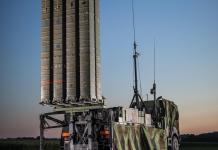The UK is reportedly utilizing state-of-the-art technology, including Artificial Intelligence, to bolster the advancement of its next-generation fighter aircraft, Tempest.
Slated to be a vital component of the UK’s future combat air system, FCAS is envisioned as a supersonic stealth fighter incorporating state-of-the-art technologies, including advanced integrated sensing and protection capabilities.
The program, a joint effort involving the UK, Italy, and Japan, will heavily depend on millions of lines of code integrated into the aircraft and ground-based systems.
This highlights the critical necessity for Tempest’s software to exhibit exceptional robustness and resilience, exceeding that of potential adversaries.
In an official statement, the Royal Air Force disclosed that leading combat air companies in the UK, alongside the Ministry of Defence, have partnered with cutting-edge scientists specializing in machine learning, artificial intelligence, data science, and computing.
This collaboration aims to contribute to developing software essential for the next-generation fighter jet. The service said that the effort yielded invaluable insights into various aspects of software, including requirements, design, delivery, operation, speed of upgrades, and maintenance.
These insights apply to the fighter jet and the training systems that pilots and maintainers will employ to operate and support the aircraft.
The Royal Air Force further said that Outsmart Insight, a deep tech intelligence company, and Oxford Creativity, a group specializing in a systematic approach to innovation and creative problem-solving, collaborated on targeted research involving scientists, engineers, and academia.
This research specifically tackled the most challenging problems in software development anticipated over the program’s multi-decade lifespan.
These challenges included devising flexible methods for managing computing resources, defining the role of trusted artificial intelligence, exploring software reuse strategies, and enhancing overall software dependability.
In light of the findings, Team Tempest partners are conducting additional targeted research with UK academia. The goal is to bolster the development of more resilient software, aligning with the program’s vision for a contemporary, efficient, secure, and continually advancing software delivery ecosystem.
Foundational Role Of Software In Crafting Sixth-Generation Fighter Jet
The development of the next generation of fighter jets is considered crucial in addressing security concerns for all stakeholders, particularly in light of heightened Russian aggression in Europe and the expanding military influence of China in the vicinity of Japan.
However, the software is a cornerstone in building sixth-generation fighter jets. Its development is pivotal as it supports and enables the aircraft’s capabilities over the long term, playing a vital role in its overall performance, adaptability, and effectiveness in varied operational scenarios.
Air Commodore Lowe, FCAS Program Director for the MoD, highlighted software’s pivotal role in the Tempest program, emphasizing its criticality due to the evolving operational landscape that requires adaptability through regular software updates.
However, he also underscored the substantial risks associated with software development. Lowe explained that recent events have illustrated the hazards of poor software implementation, contrasting with the considerable benefits of proficient software execution.
He suggests that, in terms of operational capability, those responsible for delivering the software are as vital as the individuals maintaining the aircraft or piloting them.
Given the rising integration of autonomous features and artificial intelligence (AI) in next-gen fighter jets, the software empowers these aircraft to autonomously execute tasks like in-flight decision-making, threat detection, and target engagement.

For example, the United States has previously disclosed that its Next-Generation Air Dominance (NGAD) fighter is designed to enable real-time software updates for its hardware. This will allow the aircraft to address software bugs or unlock additional capabilities while airborne swiftly.
The US Air Force revealed that the NGAD fighter employs a distinct approach by isolating its flight-control software from the broader aircraft computer system.
This separation includes software responsible for communication, networking, radar, electronic warfare, weapon control, and other functions.
In contrast to current fighters, which integrate all software on a single central computer system, the NGAD’s segregated software architecture eliminates the need for extensive flight tests after significant software upgrades.
This reduces the likelihood of unforeseen impacts on the aircraft’s flight controls, streamlining the update process.
With the assurance that the flight control software functions autonomously within predefined parameters, the NGAD and potentially all future Air Force aircraft can efficiently receive software updates without requiring supplementary flight testing.
Overall, this approach aims to significantly improve the responsiveness and efficiency of software updates for military aircraft.
- Contact the author at ashishmichel(at)gmail.com
- Follow EurAsian Times on Google News




